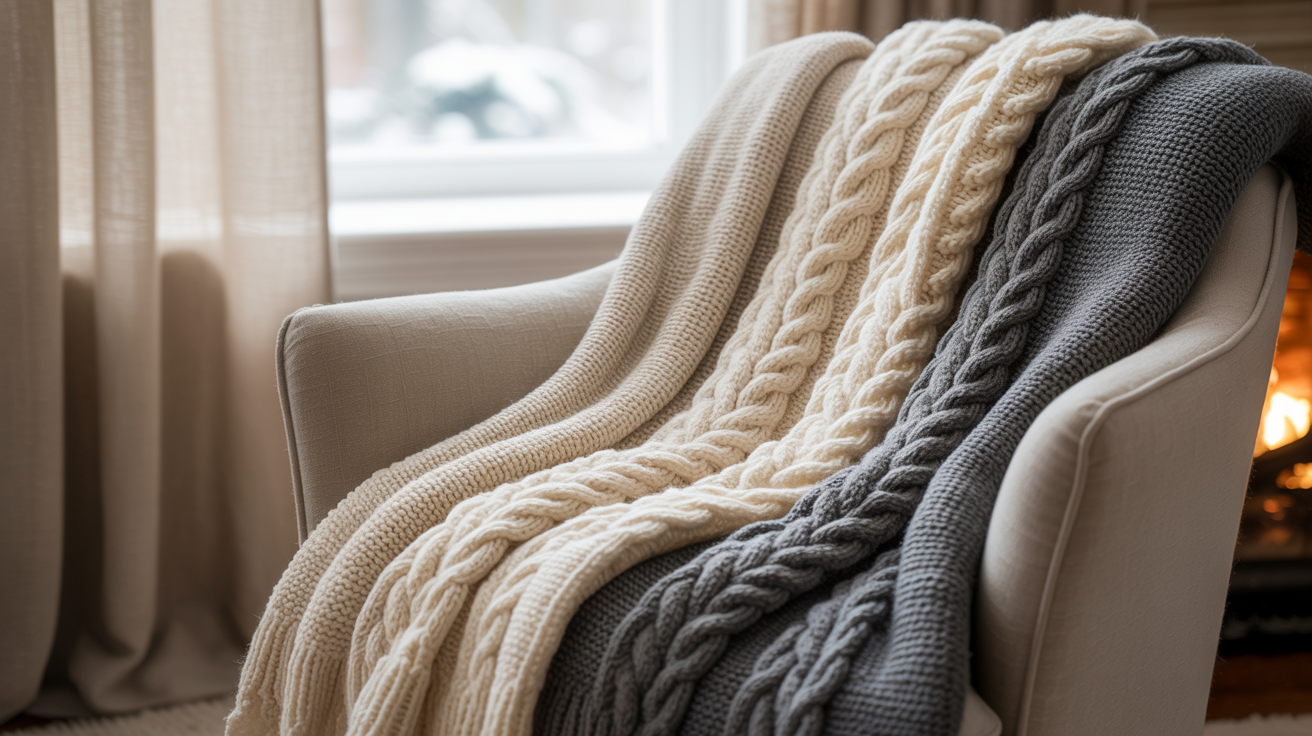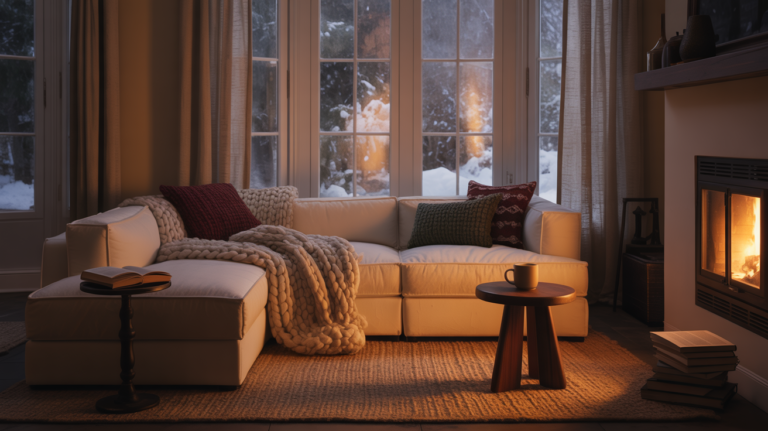Winter doesn’t have to mean dreary interiors. As temperatures drop and we spend more time indoors, transforming your home into a cozy sanctuary becomes essential. Whether you’re transitioning from holiday decor or starting fresh, these 29 winter decorating ideas will help you create a warm, stylish space that makes those long, cold months feel like a luxurious retreat.
The secret to successful winter decorating? Layering comfort while maintaining style. Unlike holiday-specific decor that gets packed away on January 2nd, thoughtful winter decorating carries you through the entire season—from early January’s fresh start through March’s final snow flurries.
Layer Textures for Maximum Warmth
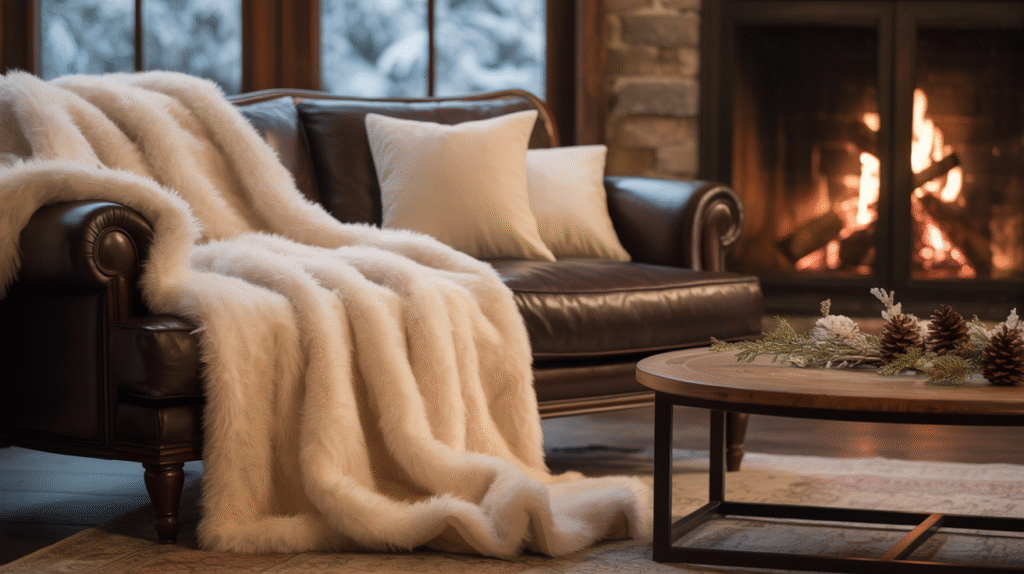
1. Stack chunky knit throws on every seating surface. Drape cable-knit blankets over sofas, armchairs, and the foot of your bed. These tactile pieces instantly signal comfort while providing actual warmth. Choose oversized throws in neutral tones like cream, oatmeal, or soft gray to complement any color scheme—they’re as functional as they are decorative.
2. Add faux fur accents strategically. Place sheepskin rugs beside your bed, faux fur pillows on the couch, or a plush throw over your reading chair. The visual softness creates an irresistible invitation to curl up. Faux fur has become the go-to texture for winter spaces because it delivers maximum coziness without overwhelming a room. One well-placed sheepskin can transform cold hardwood floors into a warm landing spot for your feet each morning.
3. Swap lightweight curtains for heavy drapes. Rich, thick curtains in velvet or lined linen not only keep drafts out but also bring a luxurious, cocooning effect to any room. This isn’t just about aesthetics—heavy drapes can reduce heat loss through windows by up to 25%, making your space both warmer and more energy-efficient. Consider deep navy, charcoal gray, or rich chocolate brown for a sophisticated winter look.
4. Layer rugs for added depth and insulation. Place a smaller, textured rug over your existing carpet or larger area rug. This builds visual interest while providing an extra barrier against cold floors. Try layering a sheepskin or high-pile rug over a flat-weave jute rug for an on-trend look that’s also incredibly practical. The contrast between textures adds dimension while the layers trap warmth.
5. Introduce velvet cushions in jewel tones. Deep blues, emerald greens, or rich burgundy velvet pillows bring sophistication and tactile luxury to your seating areas. Velvet’s pile catches light differently throughout the day, creating subtle visual interest. Mix velvet cushions with your chunky knit throws and faux fur accents for a perfectly layered look that invites touch.
Embrace Natural Winter Elements
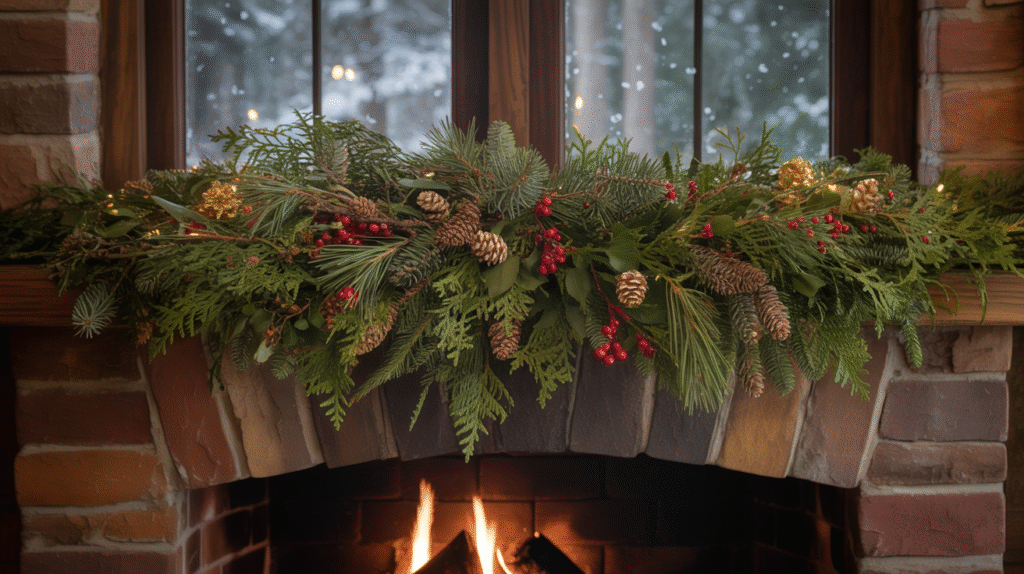
6. Create a fresh evergreen arrangement for your mantel. Combine pine, cedar, and fir branches with pine cones for an authentic winter scent and look that celebrates the season naturally. Fresh evergreens remain one of the most consistently recommended winter decor elements because they bring the outdoors in while filling your home with that distinctive winter fragrance. Replace the branches every two to three weeks to maintain freshness.
7. Fill decorative bowls with pine cones. This effortless decor idea works on coffee tables, dining tables, or console tables. Mix sizes and varieties for visual interest. Pine cones cost nothing if you collect them yourself during winter walks, making this one of the most budget-friendly decorating ideas. For added elegance, lightly dust them with white paint for a frosted effect, or leave them natural for organic warmth.
8. Display winter blooms like amaryllis and paperwhites. These seasonal flowers bring life and elegance to winter spaces, especially when placed on kitchen counters or dining tables in simple white vessels. While the world outside may look dormant, these spectacular blooms prove that winter can be vibrant. Paperwhites are particularly rewarding—they grow quickly from bulbs and fill your home with sweet fragrance during the darkest months.
9. Incorporate birch bark elements. Birch logs stacked beside the fireplace, birch candleholders, or birch branch arrangements bring organic texture with a distinctly winter feel. The white bark with its characteristic black markings evokes snowy landscapes while adding sculptural interest. Bundle birch branches in a tall vase for an instant winter statement, or use birch rounds as natural coasters and trivets.
10. Craft a eucalyptus and evergreen centerpiece. Combine fresh eucalyptus with pine branches in a long, low arrangement for your dining table—the scent alone transforms your space. This combination offers the best of both worlds: eucalyptus provides silvery-green foliage and a spa-like aroma, while pine branches deliver that classic winter scent. The arrangement stays fresh for weeks and works beautifully from casual family dinners to elegant entertaining.
Master the Winter Color Palette
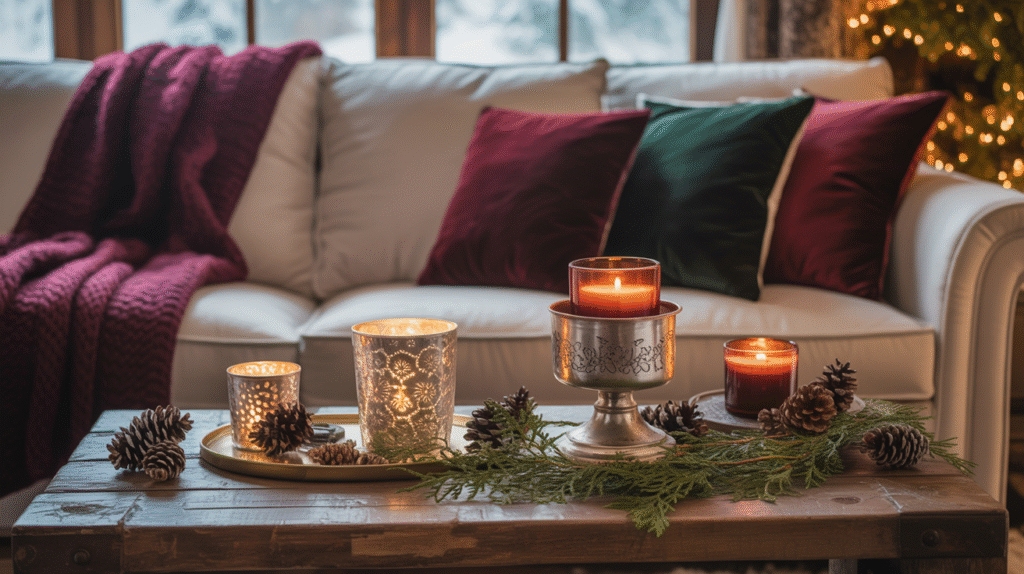
11. Transition to icy blues and crisp whites. After the holidays, pack away reds and greens in favor of a palette inspired by snow-covered landscapes and bright winter skies. This color shift signals a fresh start to the new year while maintaining seasonal appropriateness. Think of a snow-covered meadow against a brilliant blue sky—that’s your winter color inspiration. These cool tones build a serene, sophisticated atmosphere that feels both calming and invigorating.
12. Add metallic accents in silver and pewter. These cool-toned metals evoke ice and frost while adding sophisticated shimmer to surfaces and shelving. Unlike warm-toned gold and brass that dominate during the holidays, silver and pewter feel distinctly winter-appropriate. Introduce these metals through picture frames, candleholders, trays, or decorative objects. The reflective quality amplifies natural light during short winter days.
13. Incorporate earthy browns and warm woods. Balance cool tones with natural wood elements and brown leather to prevent your space from feeling too cold. Without warm elements, a blue-and-white palette can feel sterile rather than serene. Wooden bowls, cutting boards displayed as art, leather-bound books, or a rich walnut side table provide necessary warmth. The key is achieving balance between cool and warm tones.
14. Choose plaid patterns in muted navy and cream. Skip the holiday red-and-green plaid for sophisticated navy, cream, or gray patterns that work throughout winter. Plaid remains a winter classic, but the color story makes all the difference. A navy-and-cream plaid throw feels refined and works seamlessly from January through March, while red-and-green immediately reads as Christmas-specific. Look for subtle, large-scale plaids rather than bright, busy patterns.
15. Use clear glass as a decorating element. Glass vases, bowls, and candleholders represent ice-covered surfaces while maintaining an airy, uncluttered aesthetic. This is especially important in winter when reduced natural light can make spaces feel heavy. Clear glass hurricane vases filled with white candles, glass bowls displaying white ornaments or pine cones, or simple glass bud vases with single stems deliver winter elegance without visual weight.
Create Ambient Lighting and Warmth
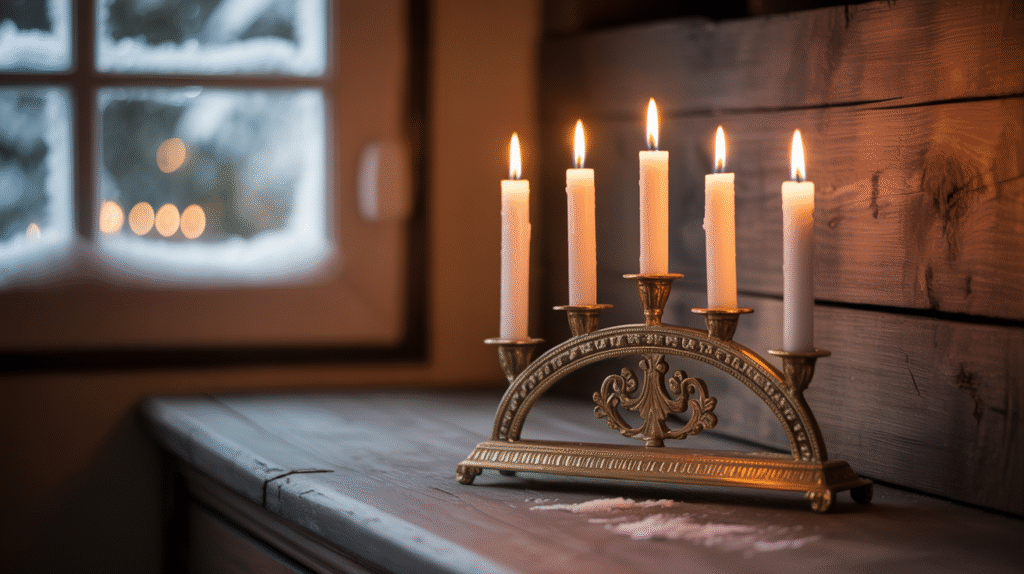
16. Cluster candles of varying heights on trays. Group pillar candles on mirrored or wooden trays for your coffee table or mantel. The flickering light creates instant coziness. Candles appear in virtually every winter decorating guide because they deliver both literal and emotional warmth. Use unscented candles in living areas if you’re also using scented candles elsewhere—you don’t want competing fragrances. A mirrored tray amplifies candlelight beautifully.
17. Invest in vintage-style candleholders. Antique brass or distressed metal candleholders bring character while serving the practical purpose of ambient lighting. These pieces work year-round but shine especially bright during winter when we rely more heavily on candlelight. Scour antique shops, estate sales, or online marketplaces for unique finds. The patina and character of vintage candleholders provide warmth that new pieces simply can’t replicate.
18. Add floor lamps to dark corners. A well-placed floor lamp with a warm-toned bulb eliminates harsh overhead lighting and creates intimate pools of light. Winter’s short days mean we’re using artificial light more than any other season. Instead of relying on overhead fixtures that can feel stark, layer lighting at different heights. A floor lamp in a reading corner or beside a sofa builds ambiance while providing functional task lighting.
19. Use table lamps to layer lighting. Ceramic or wooden table lamps on side tables, consoles, and nightstands provide adjustable warmth and eliminate the need for bright overhead fixtures. The key to cozy winter lighting is having multiple light sources at various heights that you can adjust based on time of day and activity. Lamps with fabric shades cast warmer light than those with glass or metal shades—an important consideration for winter.
20. String subtle fairy lights in unexpected places. Drape warm white lights along mantels, weave them through greenery, or place them in glass hurricanes for a magical glow. Battery-operated LED string lights have revolutionized winter decorating. Unlike the large, colored bulbs associated with holidays, delicate warm-white fairy lights build sophisticated ambiance. They’re especially effective woven through evergreen garland or coiled inside a large glass vase as a centerpiece.
Style Specific Spaces
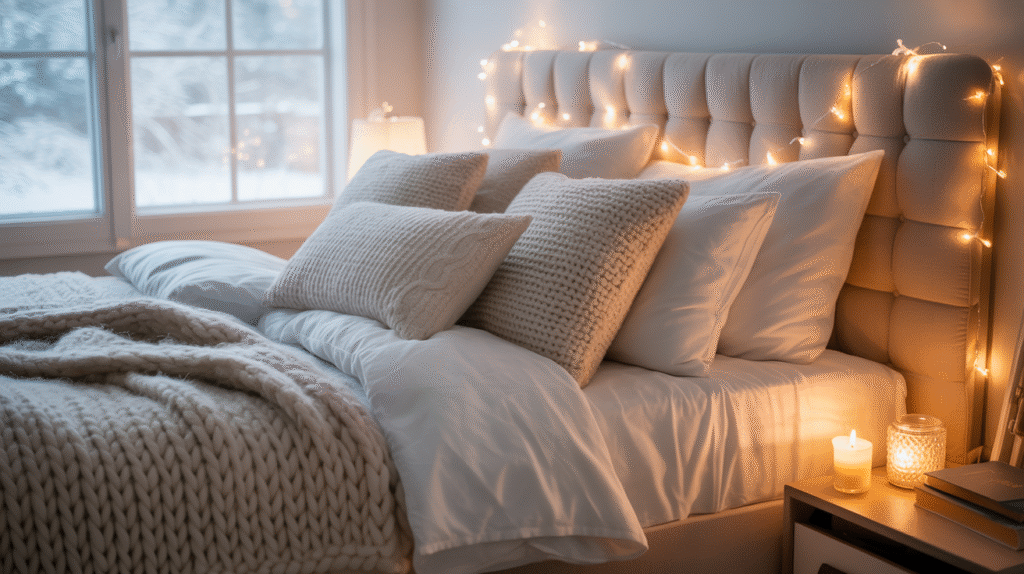
21. Transform your mantel into a winter focal point. Layer evergreen garland, place candlesticks of varying heights, incorporate natural elements like pine cones, and finish with a mirror or artwork above to reflect the flickering candlelight. Your mantel serves as the room’s anchor, so invest time here. Start with fresh evergreen garland as your base, then build up with candlesticks (odd numbers work best visually), add texture with pine cones or birch bark, and finish with personal touches like vintage books or a collected object.
22. Create a cozy reading nook. Position a boucle swivel chair near a window, place a floor lamp nearby, stack books on a side table, and drape a chunky knit throw over the arm. Boucle swivel chairs have become incredibly popular in winter decor—the nubby texture feels inherently cozy while the swivel function adds versatility. This dedicated cozy corner gives you a destination within your home, making long winter evenings feel intentional rather than confining.
23. Style a winter coffee table vignette. Use a wooden or mirrored tray as your base, place a small evergreen arrangement inside, cluster candles around it, and include a decorative object like a vintage bowl filled with pine cones. Coffee table styling follows a simple formula: start with a tray to anchor your arrangement, add height with candles or a small arrangement, include something organic like pine cones or a plant, and finish with something personal or unexpected. Keep it low enough to see over when seated.
24. Refresh your bedroom with winter bedding. Layer a plush duvet, swap in flannel or jersey sheets, pile on textured pillows, and place a chunky knit throw at the foot of the bed. Your bedroom deserves special attention in winter since we spend more time there during long, dark evenings. Flannel sheets feel like a warm hug, while a substantial duvet creates that cloud-like bed you can’t wait to sink into. The throw at the foot serves double duty—it’s decorative and provides extra warmth when needed.
25. Design an inviting entryway. Hang a fresh evergreen wreath on your door, place a basket with rolled blankets nearby, and position a runner rug to warm up the entrance. Your entryway sets the tone for your entire home. A basket of rolled throws isn’t just decorative—it’s functional, offering guests a cozy blanket if they’re chilly. A runner rug in a winter-appropriate pattern protects floors from wet boots while adding warmth underfoot.
Add Charming Winter Details
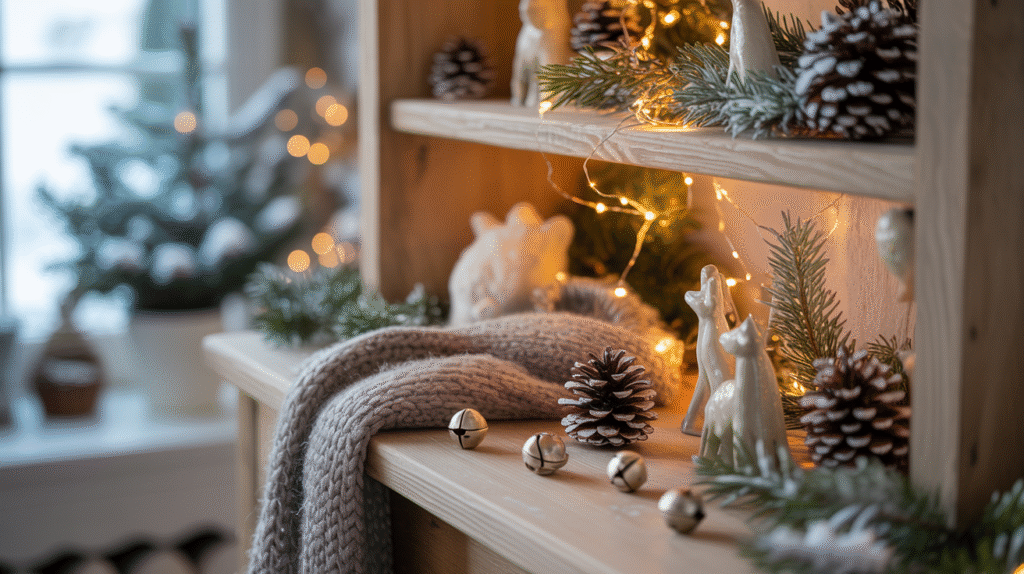
26. Display decorative mittens as seasonal art. Hang vintage or handmade mittens on a decorative ladder, create button-art mitten designs for wall decor, or use them as unexpected garland. This charming detail brings personality without feeling childish. Vintage mittens from antique shops or handmade mittens from craft fairs become folk art when displayed intentionally. Clip them to twine with small clothespins and string across a mantel, or frame a particularly beautiful pair as textile art.
27. Curate winter-themed shelving displays. Arrange books with white or blue spines, intersperse with white ceramic pieces, tuck in small evergreen sprigs, and include natural wood elements. Bookshelves offer prime real estate for seasonal styling. Pull books with winter-appropriate colors to the front, style horizontally in small stacks, and use them as platforms for decorative objects. Tuck small evergreen sprigs between books for organic texture. This approach works whether you have built-ins or freestanding shelves.
28. Bring the Alpine aesthetic indoors. Incorporate ski lodge elements like plaid blankets, antler decor (real or faux), rustic wood pieces, and mountain-inspired artwork.
The ski chalet look has enduring appeal because it embodies winter coziness. You don’t need to live near mountains to embrace this aesthetic.
A plaid wool blanket, a piece of driftwood or antler displayed on a shelf, and artwork featuring winter landscapes creates the mood.
This style works especially well in cabins, mountain homes, or anywhere you want that après-ski feeling.
29. Shop your home first. Walk through your space and gather objects that fit your winter color palette—white vases, silver frames, wooden bowls, blue ceramics—then rearrange them into cohesive winter displays.
You likely own more winter-appropriate decor than you realize. That white ceramic pitcher you use year-round? Fill it with evergreen branches. Those blue-and-white dishes? Display them on open shelving.
The wooden cutting boards? Lean them against your kitchen backsplash. Shopping your home costs nothing and often yields the most authentic results.
Making Winter Decor Work for You
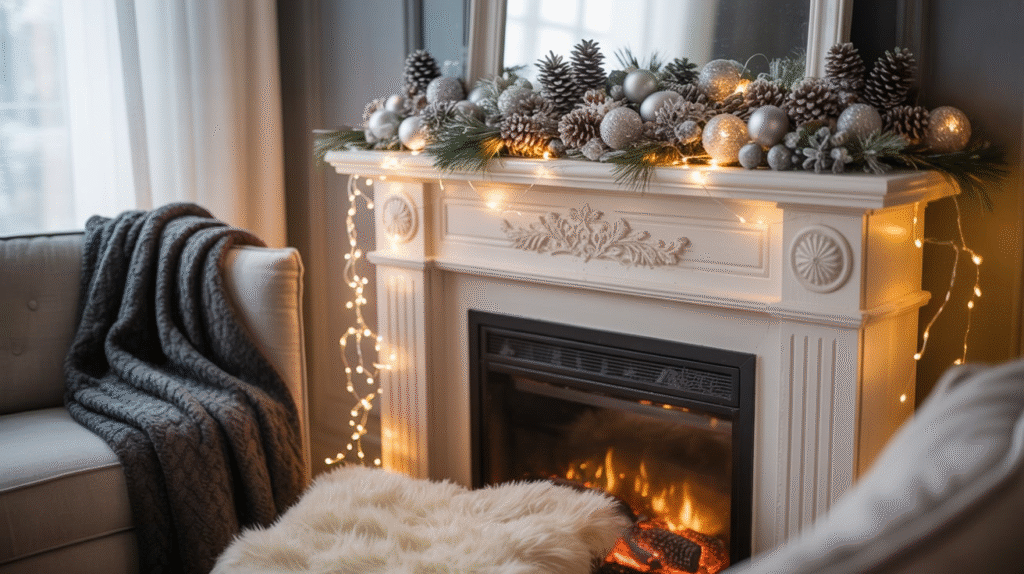
The beauty of these winter decorating ideas lies in their versatility and longevity. These elements work throughout the entire season, from early January through March—strategic decorating that serves you for months rather than weeks.
Focus on investments that serve dual purposes: chunky throws that provide warmth and style, candles that offer both light and ambiance, and natural elements that bring the outdoors in while celebrating the season.
The most successful winter spaces layer multiple textures—soft against rough, matte against shiny, natural against refined—to create depth and visual interest.
Consider why these elements work. Layered textures literally trap warm air, making spaces feel warmer.
Candlelight mimics firelight, which humans are hardwired to find comforting. Natural elements like evergreens and wood connect us to nature even when we’re spending more time indoors.
These aren’t just aesthetic choices—they’re responding to our fundamental needs during winter months.
The color palette shift matters too. After weeks of saturated holiday reds and greens, our eyes crave the calm of winter whites and blues.
These colors reduce visual stimulation, creating spaces that feel restful rather than energizing—exactly what we need when the world outside feels harsh and demanding.
Don’t feel pressured to implement all 29 ideas at once. Start with the spaces where you spend the most time: your living room, bedroom, or a cozy reading corner.
Even small changes—swapping throw pillows, adding a basket of throws, or clustering candles on your coffee table—can dramatically shift the atmosphere.
Budget-conscious decorators should prioritize natural elements (free pine cones and evergreen clippings from your yard), textiles (throws and pillows you’ll use for years), and lighting (candles and bulbs are inexpensive but transformative). Save splurges for investment pieces like quality curtains or a statement chair that will serve you beyond winter.
Your Winter Sanctuary Awaits
Ready to transform your home into a winter sanctuary? Start with three ideas from this list that resonate with your style and space.
Perhaps you’ll begin with a fresh evergreen arrangement for your mantel, swap your throw pillows for velvet ones in jewel tones, and cluster candles on your coffee table.
Or maybe you’ll layer a sheepskin rug in your bedroom, hang a simple evergreen wreath, and rearrange your bookshelf with winter colors in mind.
The goal isn’t perfection—it’s creating a home that feels warm, inviting, and uniquely yours during the coldest months of the year.
Winter decorating should make you excited to spend evenings at home, eager to invite friends over for cozy gatherings, and grateful for your warm sanctuary when the wind howls outside.
Your cozy winter retreat is just a few thoughtful touches away. Which idea will you try first?

